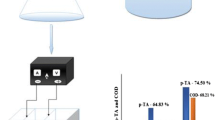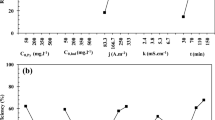Abstract
Indole is a highly recalcitrant aromatic heterocyclic organic compound consisting of a five-membered nitrogen-containing pyrrole ring fused to a six-membered benzene ring. This study presents the results of the electro-chemical mineralization of indole in an aqueous solution using platinum-coated titanium (Pt/Ti) electrode. A central composite design was used to investigate the effect of four parameters namely initial pH (pHo), current density (j), conductivity (k) and treatment time (t) at 5 levels. Multiple responses namely chemical oxygen demand (COD) removal (Y 1) and specific energy consumption (Y 2) were simultaneously maximized and minimized, respectively, by optimizing the parameters affecting the mineralization of indole by using the desirability function approach. At the operating conditions of pH 8.6, j = 161 A/m2, k = 6.7 mS/cm and t = 150 min, 83.8% COD removal with specific energy consumption of 36.3 kWh/kg of COD removed was observed. Ultra performance liquid chromatography, UV–visible spectroscopy, Fourier transform infrared spectroscopy and cyclic voltammetry of the indole solution were performed at the optimum condition of the treatment so as to report a plausible mechanism of indole degradation. Field emission scanning electron microscopy analysis of electrodes before and after treatment was performed for determining the changes on anode surface during the treatment. Thermal analysis of the solid residue (scum) obtained was also performed for exploring its disposal prospects. Present study shows that electro-chemical oxidation can be used for mineralization of nitrogenous heterocyclic compounds such as indole.







Similar content being viewed by others
References
Baghban E, Mehrabani-Zeinabad A, Moheb A (2014) Improvement of cadmium ion electrochemical removal from dilute aqueous solutions by application of multi-stage electrolysis. Int J Environ Sci Technol 11:1591–1600
Bensalah N, Louhichi B, Abdel-Wahab A (2012) Electrochemical oxidation of succinic acid in aqueous solutions using boron doped diamond anodes. Int J Environ Sci Technol 9:135–143
Bhaskar-Raju G, Thalamadai-Karuppiah M, Latha SS, Latha-Priya D, Parvathy S, Prabhakar S (2008) Treatment of wastewater from synthetic textile industry by electrocoagulation-electrooxidation. Chem Eng J 144:51–58
Burd VN, Bantleon R, Van Pee KH (2001) Oxidation of indole and indole derivatives catalyzed by nonhemechloroperoxidases. Appl Biochem Microbiol 37:248–250
Chen-Yang YW, Li JL, Wu TL, Wang WS, Hon TF (2004) Electropolymerization and electrochemical properties of (N-hydroxyalkyl)pyrrole/pyrrole copolymers. Electrochim Acta 49:2031–2040
Collin G, Hoke H (1995) Tar and pitch. In: Elvers B, Hawkins S, Russey W (eds) Ullmann’s encyclopedia of industrial chemistry, vol A26. VCH, Weinheim, pp 91–127
Comninellis C, Nerini A (1995) Anodic oxidation of phenol in the presence of NaCl for waste water treatment. J App Electrochem 25:23–28
Derringer G, Suich R (1980) Simultaneous optimization of several response variables. J Qual Technol 12:214–219
Ebenazar V, Kumar A, Yeom IT, Rajesh BJ (2015) Effect of deflocculation on the efficiency of low-energy microwave pre-treatment and anaerobic biodegradation of waste activated sludge. Appl Energy 145:104–110
Enache TA, Brett AMO (2011) Pathways of electrochemical oxidation of indolic compounds. Electroanalysis 23(6):1337–1344
Erciyes N, Gürten A, Abdullah M, Ahmed A (2004) Adsorption of indole and 2-methylindole on ligand-exchange matrix. J Colloid Interf Sci 278:91–95
Fukuoka K, Tanaka K, Ozeki Y, Kanaly RA (2015) Biotransformation of indole by Cupriavidus sp. strain KK10 proceeds through N-heterocyclic-and carbocyclic-aromatic ring cleavage and production of indigoids. Int Biodeter Biodegr 97:13–24
Hac-Uan D, Rajesh BJ, Yeom IT (2013) Effects of sludge pre-treatment on sludge reduction in a lab-scale Anaerobic/Anoxic/Oxic system treating domestic wastewater. Int J Environ Sci Technol 10:495–502
Hammouda SB, Fourcade F, Assadi A, Soutrel I, Adhoum N, Amrane A, Monseraa L (2016) Effective heterogeneous electro-Fenton process for the degradation of a malodorous compound, indole, using iron loaded alginate beads as are usable catalyst. Appl Catal B Environ 182:47–58
Hiwarkar AD, Srivastava VC, Mall ID (2014) Simultaneous adsorption of nitrogenous heterocyclic compounds by granular activated carbon: parameter optimization and multi-component isotherm modeling. RSC Adv 4:39732–39742
Hiwarkar AD, Srivastava VC, Mall ID (2015) Comparative studies on adsorptive removal of indole by granular activated carbon and bagasse fly ash. Environ Prog Sustain Energy 34(2):492–503
Kamath AV, Vaidyanathan CS (1991) Biodegradation of indoles. J Indian Inst Sci 71:1–24
Katapodis P, Moukouli M, Christakopoulos P (2007) Biodegradation of indole at high concentration by persolvent fermentation with the thermophilic fungus Sporotrichum thermophile. Int Biodeter Biodegr 60:267–272
Kavitha S, Kumar A, Kaliappan S, Yeom IT, Rajesh BJ (2015) Achieving profitable biological sludge disintegration through phase separation and predicting its anaerobic biodegradability by non-linear regression modelling. Chem Eng J 279:478–487
Kavitha S, Sally G, Rajashankar K, Yeom IT, Rajesh BJ (2016) Enhancement of aerobic biodegradability potential of municipal waste activated sludge by ultrasonic aided bacterial disintegration. Bioresour Technol 200:161–169
Kumar S, Singh S, Srivastava VC (2015) Electro-oxidation of nitrophenol by ruthenium oxide coated titanium electrode: parametric kinetic and mechanistic study. Chem Eng J 263:135–143
Kushwaha JP, Srivastava VC, Mall ID (2010) Organics removal from dairy wastewater by electrochemical treatment and residue disposal. Sep Purif Technol 76:198–205
Kushwaha JP, Srivastava VC, Mall ID (2011) Studies on electrochemical treatment of dairy wastewater using aluminum electrode. AIChE J 57(9):2589–2598
Lataye DH, Mishra IM, Mall ID (2006) Removal of pyridine from aqueous solution by adsorption on bagasse fly ash. Ind Eng Chem Res 45:3934–3943
Li YM, Gu GW, Zhao JF, Yu HQ, Qiu YL, Peng YZ (2003) Treatment of coke-plant wastewater by biofilm systems for removal of organic compounds and nitrogen. Chemosphere 52:997–1005
Linares-Hernandez I, Barrera-Diaz C, Bilyeu B, Juarez-GarciaRojas P, Campos-Medina E (2010) A combined electrocoagulation-electroxidation treatment of industrial wastewater. J Hazard Mater 175:688–694
Maljaei A, Arami M, Mahmoodi NM (2009) Decolorization and aromatic ring degradation of colored textile wastewater using indirect electrochemical oxidation method. Desalination 249:1074–1078
Martínez-Huitle CA, Brillas E (2009) Decontamination of wastewaters containing synthetic organic dyes by electrochemical methods: a general review. Appl Catal B Environ 87:105–145
Martínez-Huitle CA, Ferro S (2006) Electrochemical oxidation of organic pollutants for the wastewater treatment: direct and indirect processes. Chem Soc Rev 35:1324–1340
Martínez-Huitle CA, Rodrigo MA, Sirés I, Scialdone O (2015) Single and coupled electrochemical processes and reactors for the abatement of organic water pollutants: a critical review. Chem Rev 115:13362–13407
Merline J, Kumar A, Kaliappan S, Yeom IT, Rajesh BJ (2013) Effect of extracellular polymeric substances (EPS) on sludge reduction potential of bacillus licheniformis. Int J Environ Sci Tech 8:85–92
Muneer M, Saquib M, Qamar M, Bahnemann D (2010) Photocatalyzed reaction of indole in an aqueous suspension of titanium dioxide. Res Chem Intermed 36:121–125
Ndjomgoue-Yossa AC, Nanseu-Njiki CP, Kengne IM, Ngameni E (2015) Effect of electrode material and supporting electrolyte on the treatment of water containing Escherichia coli by electrocoagulation. Int J Environ Sci Technol 12:2103–2110
Novotny M, Starand JW, Smith SL, Wiesler D, Schwende FJ (1981) Compositional studies of coal tar by capillary gas chromatography/mass spectrometry. Fuel 60:213
Ochiai M, Wakabayash K, Sugimura T, Nagao M (1986) Mutagenicities of indole and 30 derivatives after nitrite treatment. Mut Res 172:189
Panizza M, Cerisola G (2006) Electrochemical oxidation of aromatic sulphonated acids on a boron-doped diamond electrode. Int J Environ Pollut 27:64–74
Panizza M, Cerisola G (2009) Direct and mediated anodic oxidation of organic pollutants. Chem Rev 109:6541–6569
Prabhakaran D, Kannadasan T, Basha CA (2009) Treatability of resin effluents by electrochemical oxidation using batch recirculation reactor. Int J Environ Sci Technol 6:491–498
Rajab M, Heim C, Letzel T, Helmreich B (2016) Oxidation of bisphenol A by a boron-doped diamond electrode in different water matrices: transformation products and inorganic by-products. Int J Environ Sci Technol. doi:10.1007/s13762-016-1087-z
Rajesh BJ, Hac-Uan D, Kumar A, Yeom IT (2001) Effect of low temperature thermochemical pre-treatment on sludge reduction capacity of MBR treating secondary treated dairy wastewater. Water Qual Res J Can 46:312–320
Rameshraja D, Srivastava VC, Kushwaha JP, Mall ID (2012) Quinoline adsorption onto granular activated carbon and bagasse fly ash. Chem Eng J 181–182:343–351
Sengil IA, Ozdemir A (2012) Simultaneous decolorization of binary mixture of blue disperse and yellow basic dyes by electrocoagulation. Desalin Water Treat 46:215–226
Singh S, Srivastava VC, Mall ID (2013) Mechanistic study of electrochemical treatment of basic green 4 dye with aluminum electrodes through zeta potential, TOC, COD and color measurements, and characterization of residues. RSC Adv 3:16426–16439
Singh S, Srivastava VC, Mall ID (2014a) Electrochemical treatment of dye bearing effluent with different anode–cathode combinations: mechanistic study and sludge analysis. Ind Eng Chem Res 53:10743–10752
Singh S, Srivastava VC, Mall ID (2014b) Multi-step optimization and residue disposal study for electrochemical treatment of textile wastewater using aluminium electrode. Int J Chem React Eng 11(1):31–46
Singh S, Lo SL, Srivastava VC, Hiwarkar AD (2016) Comparative study of electrochemical oxidation for dye degradation: parametric optimization and mechanism identification. J Environ Chem Eng 4:2911–2921
Thakur C, Srivastava VC, Mall ID (2009) Electrochemical treatment of a distillery wastewater: parametric and residue disposal study. Chem Eng J 148:496–505
Zaid B, Aeiyach S, Lacaze PC (1994) Electropolymerization of pyrrole in propylene carbonate on zinc electrodes modified by heteropolyanions. Synth Met 65:27–34
Zhang H, Song H (2012) Study of adsorptive denitrogenation of diesel fuel over mesoporous molecular sieves based on breakthrough curves. Ind Eng Chem Res 51:16059–16065
Acknowledgements
Corresponding author (VCS) is thankful to the Water Technology Initiative (WTI) program (grant no. DST/TM/WTI/2k13/127) of the Department of Science and Technology (DST), India, for providing financial help for carrying out this work.
Author information
Authors and Affiliations
Corresponding author
Additional information
Editorial responsibility: M. Abbaspour
Electronic supplementary material
Below is the link to the electronic supplementary material.
Rights and permissions
About this article
Cite this article
Hiwarkar, A.D., Singh, S., Srivastava, V.C. et al. Electro-chemical mineralization of recalcitrant indole by platinum-coated titanium electrode: multi-response optimization, mechanistic and sludge disposal study. Int. J. Environ. Sci. Technol. 15, 349–360 (2018). https://doi.org/10.1007/s13762-017-1391-2
Received:
Revised:
Accepted:
Published:
Issue Date:
DOI: https://doi.org/10.1007/s13762-017-1391-2




